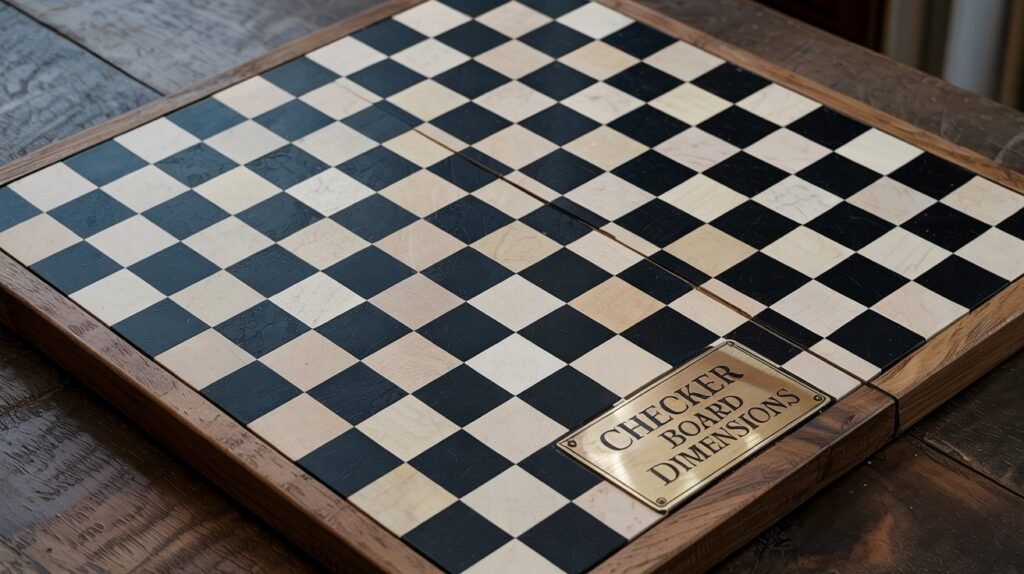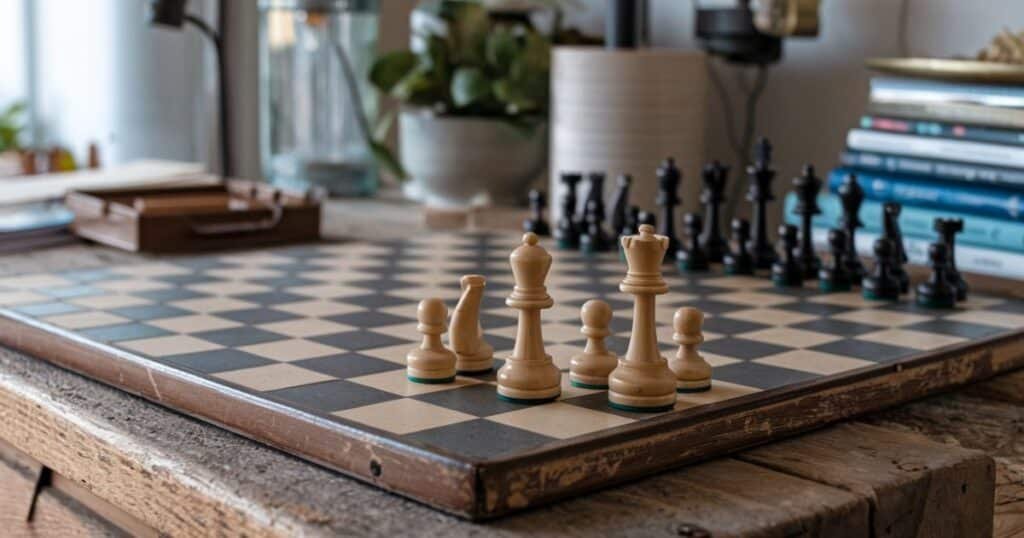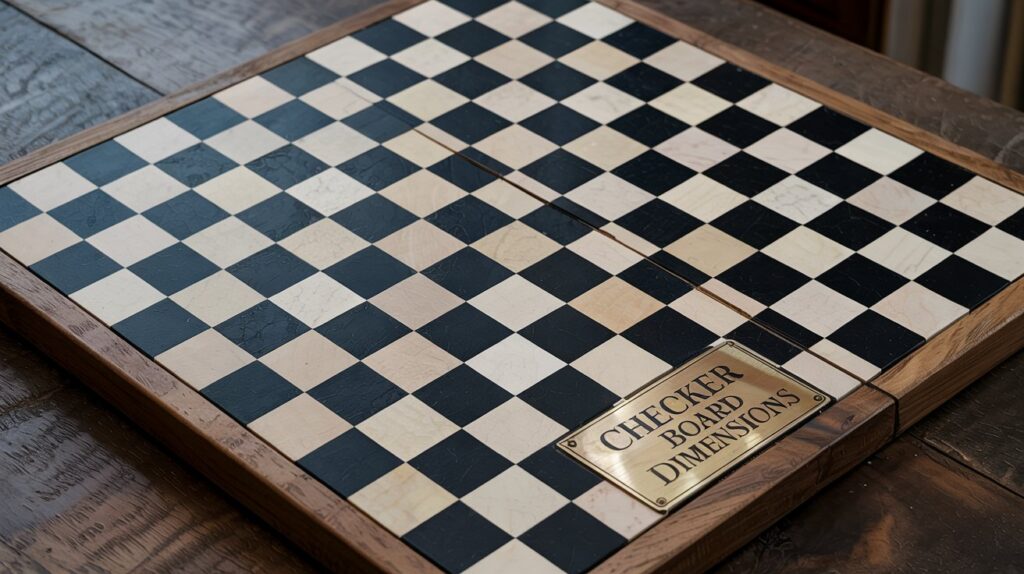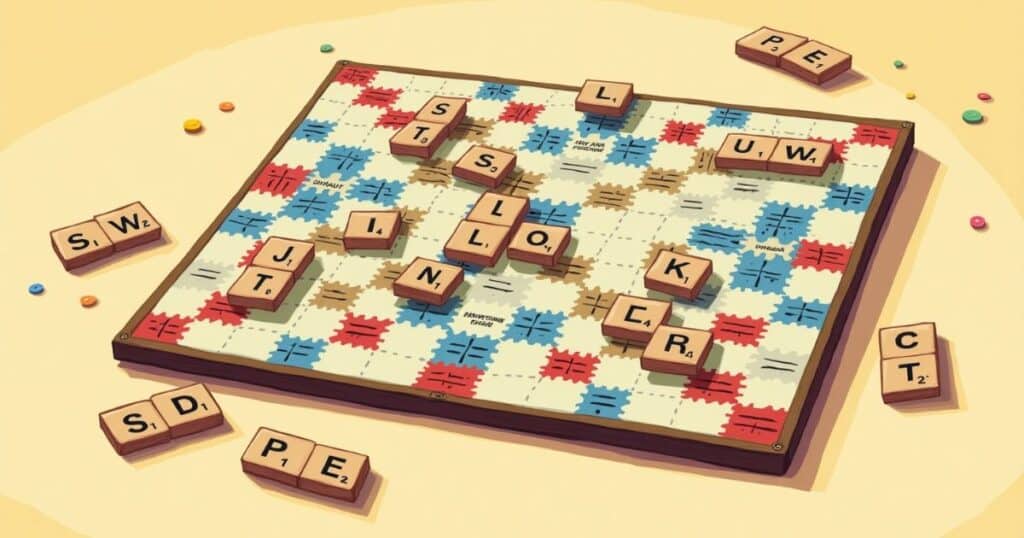Chess and checkers have captivated minds for centuries, bringing people together across tables small and large.
But have you ever wondered about the exact dimensions that make these iconic boards work so perfectly?
Whether you’re crafting your own board, shopping for a quality set, or simply curious about the mathematics behind these timeless games, the dimensions of a checker board matter more than you might think.
How Big is a Standard Checker Board?
A standard checker board measures 8 squares by 8 squares, creating a perfect square playing surface.
The physical dimensions typically range from 14 to 20 inches for the entire board, with tournament-sized checker boards usually measuring exactly 16 inches square.
This size has proven ideal for comfortable play, allowing players to easily see the entire board while comfortably reaching any position without stretching or knocking over pieces.
The Perfect Balance of Form and Function
The classical checker board represents one of design’s most enduring patterns. Its alternating dark and light squares (traditionally black and red or black and white) create a visually balanced playing field that’s stood the test of time for good reason.
Let’s explore everything about these iconic boards, from their exact measurements to their fascinating history and practical applications.
Standard Checker Board Specifications
The 8×8 Grid: The Universal Standard
The defining feature of any checker or chess board is its 8×8 grid configuration, giving us 64 squares total.
This perfect square layout isn’t arbitrary it evolved over centuries to provide the ideal playing experience.
Tournament regulation checker boards must maintain specific dimensions:
- Each individual square measures 2 inches × 2 inches
- The full playing surface equals 16 inches × 16 inches
- Border areas typically add 1-2 inches to overall dimensions
- Standard checker pieces have a diameter of 1½ inches
These proportions create the perfect relationship between board size and piece size, ensuring players can easily manipulate pieces without crowding the board.
The two-inch squares provide enough space for comfortable piece movement while keeping the overall board a manageable size for tabletop play.

Material Matters: How Construction Affects Dimensions
Traditional wooden checker boards often feature frames that extend beyond the playing surface, adding approximately 1-2 inches to each side. High-quality tournament boards typically use:
- Hardwoods like maple and walnut for durability and visual contrast
- Green baize or felt underlayment to prevent slipping and reduce noise
- Precision-cut squares with tight tolerances (±0.5mm)
Modern boards might use vinyl playing surfaces on foldable cardboard bases, which affects thickness but maintains the standard square dimensions.
Travel sets often reduce the standard dimensions proportionally, keeping the 8×8 grid while shrinking each square to as small as ¾-inch per square.
Historical Evolution of Checker Board Dimensions
The checker board pattern predates the game itself by thousands of years. Archaeological evidence suggests similar grid patterns appeared in ancient Egypt around 3000 BCE, though not necessarily with today’s standardized dimensions.
The modern 8×8 grid became the widely accepted standard during the 12th century, coinciding with chess’s spread through Europe. Before standardization, boards varied considerably:
- Ancient Egyptian “Senet” used a 3×10 grid
- Roman “Latrunculi” featured grids ranging from 7×7 to 12×12
- Medieval variants occasionally used 10×10 boards
By the 15th century, today’s familiar dimensions had become firmly established across Europe. Interestingly, the 8×8 dimension has mathematical significance beyond gaming it represents perfect balance in design and has connections to various mathematical principles like binary systems and perfect squares.
The Geometry and Mathematics Behind Checker Boards
The checker board’s perfect square shape creates fascinating mathematical properties that have intrigued mathematicians for centuries:
Perfect Symmetry
The board demonstrates multiple types of symmetry:
- Rotational symmetry (quarter turns maintain the pattern)
- Reflective symmetry along both diagonals and central axes
- Translational symmetry in the repeating square pattern
This makes it a perfect teaching tool for basic geometric concepts and symmetry operations.
The Wheat and Chessboard Problem
One famous mathematical problem involves doubling grains of wheat on successive squares starting with one grain on the first square, two on the second, four on the third, and so on.
By the 64th square, the number reaches an astronomical 9,223,372,036,854,775,808 grains demonstrating the power of exponential growth within the confines of the board’s dimensions.
See Also: Pokémon Card Sizes: The Complete Guide
The Knight’s Tour
The 8×8 dimension enables the famous “Knight’s Tour” puzzle, where a knight chess piece must visit every square exactly once.
This mathematical challenge has captivated minds for centuries and demonstrates how the board’s specific dimensions create the perfect environment for complex strategic thinking.
Manufacturing Standards and Tolerances
For competitive play, precision matters. Tournament-quality checker boards must adhere to strict dimensional standards:
- Square size tolerance: ±1mm (approximately 0.04 inches)
- Overall board flatness must not deviate more than 2mm across entire surface
- Diagonal measurements must be equal within 1mm to ensure perfect squareness
These exacting standards ensure fair play by eliminating any advantage that might come from irregular board dimensions.
Professional manufacturers use specialized equipment to maintain these tolerances, often measuring each board with digital calipers before certification for tournament use.

Cultural Variations in Checker Board Dimensions
While the 8×8 grid remains standard internationally, some regional variations exist:
International Draughts
Popular in the Netherlands, Russia, and parts of Eastern Europe, International Draughts uses:
- 10×10 grid (100 squares total)
- Typically 20 inches × 20 inches overall dimensions
- Slightly smaller individual squares (2 inches × 2 inches) than would be proportional
Canadian Checkers
This variant features:
- 12×12 grid (144 squares)
- Approximately 24 inches × 24 inches overall
- Uses the same sized pieces as standard checkers, creating a different spatial dynamic
Turkish Dama
This traditional variant uses:
- 8×8 grid like standard checkers
- But pieces move differently, requiring specialized board markings
These cultural variations demonstrate how the fundamental checker board concept adapts to different playing traditions while maintaining the crucial alternating square pattern.
DIY Checker Board Dimensions
For those interested in crafting their own checker board, proper dimensions are crucial for a satisfying playing experience:
Home Woodworking Specifications
When building a wooden checker board:
- Cut individual squares precisely to 2 inches × 2 inches
- Allow for wood expansion (approximately 1/32 inch between squares)
- Board thickness should be at least ¾ inch for stability
- Consider adding a 1-inch border for structural integrity and aesthetics
Material Selection Impact on Dimensions
Different materials require different dimensional considerations:
- Hardwoods like maple and walnut are traditional but require precise cutting tools
- Plywood offers stability but needs edge finishing
- Inlay work demands even tighter tolerances to prevent gaps developing over time
A well-crafted homemade checker board can become a family heirloom while providing the perfect playing surface for generations of enjoyment.
Checker Board Dimensions in Digital Environments
As checkers moved into the digital realm, new dimensional considerations emerged:
- Screen resolution and aspect ratio affect the perceived dimensions
- Touch interfaces require larger target areas than physical boards
- Visual cues must replace tactile feedback
Digital checker boards maintain the 8×8 grid but often adjust individual square dimensions based on the device. Mobile applications might use squares as small as 40 pixels, while large touch displays might feature squares over 100 pixels wide.
Despite these variations, the fundamental proportions remain consistent.

Practical Applications Beyond Gaming
The checker board pattern and its dimensions have applications far beyond the game itself:
In Photography and Cinematography
The pattern serves as:
- A calibration tool for camera distortion
- A reference point for special effects work
- A dimension standard for measuring lens characteristics
See Also: Pokémon Card Sizes: The Complete Guide
In Computer Vision and AI Development
The distinct, regular pattern provides:
- Easy recognition targets for machine learning
- Consistent measurement standards across different environments
- Perfect test patterns for algorithm development
In Architecture and Design
The balanced dimensions inform:
- Floor tiling patterns
- Facade designs
- Interior decorative elements with perfect proportions
This extraordinary versatility demonstrates why the checker board pattern has endured for millennia its perfect proportions create visual harmony while its precise dimensions enable countless practical applications.
Choosing the Right Checker Board Size for Your Needs
When selecting a checker board, consider how its dimensions fit your specific requirements:
For Competitive Play
Tournament players should choose:
- Standard 16 inches × 16 inches playing surface
- Two-inch squares
- High-contrast colors with non-reflective finish
For Family Recreation
Casual players might prefer:
- Slightly larger squares (2¼-2½ inches) for easier handling
- Folding boards for storage convenience
- Magnetic pieces for travel use
For Display Purposes
Decorative boards can feature:
- Larger dimensions (up to 24 inches square) for visual impact
- Exotic wood combinations for aesthetic appeal
- Thicker borders highlighting craftsmanship
The perfect checker board balances traditional dimensions with your specific playing environment and personal preferences.
Conclusion:
The dimensions of a checker board represent more than just measurements they embody centuries of gaming evolution, mathematical elegance, and cultural tradition.
From the precise 2-inch squares to the perfect 8×8 grid, every aspect of the board’s dimensions serves both practical function and aesthetic form.
Next time you sit down for a game of checkers or chess, take a moment to appreciate how these carefully calibrated dimensions create the perfect playing field.
Whether you’re using a tournament-grade wooden board or a simple travel set, the fundamental dimensions connect you to countless players throughout history who have enjoyed these games on virtually identical playing surfaces.
Look around your home how many objects can you find that share the checker board’s perfect square proportions or 8×8 grid pattern? You might be surprised at how this ancient dimensional standard continues to influence design all around us.
Read more knowledgeable blogs on Measure Take.



